Ballet glossary
This is a glossary of terms used in classical ballet .

The movements and poses in ballet are formalized and their mastery requires years of daily training. Since the history of ballet begins in Italy and then moves on to France, most of the terms in the language of ballet are still of French or, less often, Italian origin. Ballet terminology is still not standardized, and each of the major schools uses slightly different terms. Abbreviations are often used in the daily work in the ballet hall.
Explanations of the structure
The list is as follows: In the first column, the term ( in bold ), behind the term in IPA - phonetics . This is followed by the translation (in the case of terms that do not come from French or German, also the language of origin) and finally the actual definition. The last column shows an illustration of the term, if any.
If exist for a term different definitions, they are the appropriate generic term with cursive listed under points (eg arabesque penchée as a term of penchée ).
Compound terms are listed in different places according to their components ( arabesque penchée can be found under both arabesque and penchée ).
| term | pronunciation | Translation (linguistic origin) |
description | image |
|---|---|---|---|---|
A. |
||||
| Take-off leg | - | - | also short talus ; Leg that is the last to leave the ground when jumping | - |
| Ailes de Pigeon | - | "Pigeon wings" | Ballet figure in which you jump off with your right foot while at the same time throwing your left leg in the air. In the air, the right leg hits the left calf. Then land on the left leg while stretching the right leg in the air. The process is repeated with the sides reversed in order to land again on the right leg with the left leg extended, the starting position. | |
| Aplomb | aplɔ̃ | "Balance" | Ability to intercept movement ( balance ) | - |
| À la seconde | alasəgɔ͂d | "in the second" | Position the free leg to the side, in the second foot position |

|
| Allongé | alɔ̃} ʒe | "Stretched, stretching" | with arms / legs stretched out as far as possible in the opposite direction | |
| Arabesque | aʀabɛsk | "In Arabic style" | Pose, the dancer stands on one leg, the other leg is lifted back with the knee extended, named after the arabesque ornament |

|
| Arabesque penchée | aʀabɛskpɑ͂ʃe | "Inclined arabesque " | Arabesque with the legs as wide as possible and the upper body bent forward | |
| Assemblé | asɑ͂ble | "Stapled, closed" | Jump from the fifth to the fifth foot position, with one leg performing a battement jeté during the jump | - |
| Attitude | atityd | "Attitude" | Pose, the dancer stands on one leg, the other is lifted backwards, to the side or forwards, with the knee of the free leg bent | |
B. |
||||
| Balance | balɑ͂se | (Proper name) | “Waltz step” with a change of free leg | - |
| Ballet blanc | balɛblɑ͂ | "White ballet" | Term for choreographies without a plot or libretto, in which the movements and technical skills of the dancers are the focus, mostly danced in white tutus , e.g. B. white nude from La Bayadère , Les Sylphides |

|
| Ballet d'action | balɛdaksjɔ̃ | "Story ballet" | Term for choreographies in which the actions and feelings of the characters are the focus, e.g. B. first act from Giselle , Petruschka |

|
| Balloon | balɔne | (Proper name) | Jump on one leg during the jump leads the free leg a battement fondu from | - |
| Ballot | balɔte | "Shaken, rocked" | Jumping from one leg to the other, the free leg leads each one battement développé from | - |
| Barre | baʀ | "Pole" | Part of the ballet lesson is done with one or both hands “on the bar”, which serves as a balance aid |
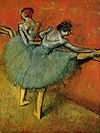
|
| Floor barre | flɔ: rbaʀ | "Boden-Stange" (English-French compound ) |
Name for basic exercises that are performed lying or sitting on the floor |

|
| Battement | batmɑ͂ | "Beat" | Term for beating movements of the free leg | |
| Battement développé | batmɑ͂ devəlɔpe | "Developed beating" | Lift one leg over the passé in extension forwards, sideways or backwards | - |
| Battery enveloppé | batmɑ͂ɑ͂vlɔpe | "Wrapped beating" | the leg stretched forwards, backwards or to the side is bent into the position passé , "opposite" of battement développé | - |
| Battement fondu | batmɑ͂fɔ͂dy | "Melted beating" | Simultaneous extension of the standing and free leg from the demi-plié ( standing leg ) or sur le cou-de-pied (free leg ) | - |
| Battement frappé | batmɑ͂fʀape | "Knocked beating" | "Tapping" movements of the free leg foot against the supporting leg | - |
| Battery tendu | batmɑ͂tɑ͂dy | "Straight hitting" | straight, extended movements of the extended free leg, the toes remain on the ground | |
| Battery tendu jeté | batmɑ͂tɑ͂dyʒəte | "Straight thrown hitting" | the extended free leg is thrown with a quick, gliding motion and lingers with the toes just above the ground in the air | - |
| Battement tendu pour battery | batmɑ͂tɑ͂dy puʀbatʀi | "Stretched hitting for battery " | quick change of the extended free leg behind and in front of (or in front of and behind) the supporting leg | - |
| Grand battement jeté | gʀɑ͂batmɑ͂ʒəte | "High thrown beating" | the free leg is thrown as high as possible forward, to the side or backward. | - |
| battery | batʀi | "Stroke sequence" | Kicking your legs together while jumping | - |
| Breeze | bʀize | "Interrupted, disturbed" | Jump to the side / front or back, with the free leg hitting the standing leg several times | - |
| Jeté brisé | ʒətebʀize | "Interrupted throwing" | Jump from one leg to the other, an entrechat is performed during the jump | - |
C. |
||||
| Cabriole | kabʀijɔl | "Jump in the air, caper" | Jump on one leg, during the jump the legs are crossed | - |
| Changement | ʃɑ͂ʒmɑ͂ | "Change" | Steps or jumps with changing the position of the feet | - |
| Change of pied saute | ʃɑ͂ʒmɑ͂dpjesote | "Jumped foot change" | Jump from both feet to both feet with changing the front foot during the jump | - |
| Character dance | - | - | stylized folk dances in a ballet, e.g. B. the mazurka in Coppélia |

|
| Chassé | ʃase | "Hunted, pursued" | - | - |
| Pas chassé | pɑʃase | "Pursued step" | Jump from an open (II. Or IV.) To an open foot position, with the feet closed in the air | - |
| Contretemps | kɔ͂tʀətɑ͂ | "Incident" | Connection step to change direction | - |
| Croisé | kʀwaze | "Crossed" | Variant of épaulement , posture, the position of the legs appears crossed or closed from the viewer's perspective |

|
| Croisé derrière | kʀwazedɛʀjɛʀ | "Crossed back" | Posture, the position of the legs appears crossed from the viewer's perspective, with the free leg being stretched or lifted backwards |
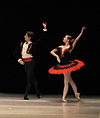
|
| Croisé devant | kʀwazed (ə) vɑ͂ | "Crossed in front" | Posture, the position of the legs appears crossed from the viewer's perspective, with the free leg stretched or lifted forwards | |
D. |
||||
| De côté | dəkote | "To the side" | Postures and movements towards the sides of the stage |

|
| Demi-plié | dəmiplije | "Half bent" | Squat in any of the foot positions without lifting your heels off the floor | - |
| Développé | devəlɔpe | "Developed" | Movement of the free leg from flexion into extension | - |
| Battement développé | batmɑ͂ devəlɔpe | "Developed beating" | Lift one leg over the passé in extension forwards, sideways or backwards | - |
E. |
||||
| Écarté | ekaʀte | "Averted" | Variant of épaulement , posture diagonally to the viewer | - |
| Écarté derrière | ekaʀtedɛʀjɛʀ | "Turned away to the rear" | Posture diagonally to the viewer, with the free leg stretched or lifted "away from the viewer" | - |
| Écarté devant | ekaʀted (ə) vɑ͂ | "Turned away to the front" | Posture diagonally to the viewer, with the free leg stretched or lifted "towards the viewer" |

|
| Effacé | efase | "Faded, insignificant" | Variation of the épaulement , posture, the legs appear uncrossed or open from the viewer's perspective |

|
| Effacé derrière | efasedɛʀjɛʀ | " Effacé to the rear" | Posture, the position of the legs appears uncrossed from the viewer's perspective, with the free leg being stretched or lifted backwards |

|
| Effacé devant | efased (ə) vɑ͂ | " Effacé forward" | Posture, the position of the legs appears uncrossed from the viewer's perspective, with the free leg stretched or lifted forwards |
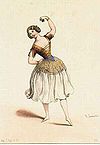
|
| En croix | ɑ͂kʀwa | "In the cross, crosswise" | Movements that are carried out in the sequence forwards ( en avant ) - sideways ( à la seconde ) - backwards ( en arrière ) - sideways ( à la seconde ) |

|
| En-dehors | ɑ͂dəɔʀ | "outward" | - | - |
| En-dehors (leg position) | ɑ͂dəɔʀ | "outward" | In classical ballet, an “outward position” of the legs is sought, this is considered aesthetic and is referred to as en dehors . |

|
| En-dehors (movement) | ɑ͂dəɔʀ | "outward" | Movements "away from the supporting leg", e.g. B. pirouette en dehors or rond de jambe par terre en dehors |

|
| En-dedans | ɑ͂dədɑ͂ | "Inside" | Movements "towards the supporting leg", e.g. B. pirouette en dedans or rond de jambe par terre en dedans |

|
| En face | ɑ͂fas | "From the front" | Postures and movements facing the audience |
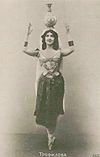
|
| Entrechat | ɑ͂tʀəʃa | (Proper name) | Jump from the fifth foot position with one to repeated crossing of feet in the air, even changement battu called | - |
| Entrée | ɑ͂tʀe | "Entry, appearance" | Single scene appearance by a dancer | - |
| Enveloppé | ɑ͂vlɔpe | "wrapped up" | - | - |
| Battery enveloppé | batmɑ͂ɑ͂vlɔpe | "Wrapped beating" | the leg stretched forwards, backwards or to the side is bent into the position passé , "opposite" of battement développé | - |
| Épaulement | epolmɑ͂ | "Alignment" | Posture towards the viewer, both shoulders and both pelvic ridges should be visible, variants: en face, de côté, croisé, effacé and écarté | - |
F. |
||||
| Fondu | fɔ͂dy | "Melted" | both legs bend and slowly stretch | - |
| Battement fondu | batmɑ͂fɔ͂dy | "Melted beating" | Simultaneous extension of the standing and free leg from the demi-plié (standing leg) or sur le cou-de-pied (free leg) | - |
| Fouette | fwete | "Whipped" | rapid, lash-like movements | - |
| Fouette en tournant | fweteɑ͂tuʀnɑ͂ | " Twisted fouette " | Rotation, rond de jambe en l'air followed by pirouette , usually danced multiple times, e.g. B. in Swan Lake or Don Quixote |

|
| Foot position | - | - | Basic position of the feet when standing on both legs; 5 positions are possible with the legs turned outwards |

|
G |
||||
| Gargouillade | gaʀgujad | (Proper name) | also double rond de jambe sauté , pas de chat in which both legs perform a rond de jambe in the air | - |
| glissade | glisad | "Slide" | Sliding step from the V. to the V. foot position, just above the ground | - |
| Glissé | glise | "Slipped, slipped" | Sliding step | - |
| Grand battement jeté | gʀɑ͂batmɑ͂ʒəte | "Big (high) thrown beating" | the free leg is thrown as high as possible forward, to the side or backward. | - |
| Grand jeté | goodness | "Big (high) throwing" | Big jump from one leg to the other, possible positions in the air are arabesque , attitude and big 2nd position |

|
| Grand plié | gʀɑ͂plije | "Great (deep) bending" | Bend the knees lower than with demi-plié , raise heels only as much as is absolutely necessary without sitting on them; in the second foot position the heels are not lifted | - |
J |
||||
| Jeté | ʒəte | "Thrown" | - | - |
| Battery tendu jeté | batmɑ͂tɑ͂dyʒəte | "Straight thrown hitting" | the extended free leg is thrown with a quick, gliding motion and lingers with the toes just above the ground in the air | - |
| Grand battement jeté | gʀɑ͂batmɑ͂ʒəte | "Big (high) thrown beating" | the free leg is thrown as high as possible forward, to the side or backward. | - |
| Grand jeté | goodness | "Big (high) throwing" | big jump from one leg to the other, possible positions in the air are arabesque, attitude and big 2nd position |

|
| Jeté sauté | ʒətesote | "Jumped throwing" | Jump from one leg to the other | - |
P |
||||
| Pas | pɑ | "Step" | - | - |
| Pas de basque | pɑdbask | "Basque Step" | multi-part connecting step | - |
| Pas de bourrée | pɑdbuʀe | " Bourrée - step" (proper name) |
Connecting step with a leg change | - |
| Pas de chat | pɑdʃa | "Cat step" | Jump from the fifth position with landing in the take-off position, both knees are bent during the jump | - |
| Pas échappé sauté | pɑeʃapesote | échapper : "to tear out" | Jump from the V to the II or IV position and back to the V | - |
| pas de deux | pɑdedø | "Steps / dance for two" | duet |

|
| Passé | pɑse | passer : "lead by, pass" | the free leg foot is placed on the knee of the supporting leg, is used to change free leg positions, e.g. B. front to back. |

|
| Penché | pɑ͂ʃe | "Inclined, tilted" | - | - |
| Arabesque penchée | aʀabɛskpɑ͂ʃe | "Inclined arabesque " | Arabesque with the legs as wide as possible and the upper body bent forward | |
| Piqué | pike | "Stung" | the tip of the toe of the extended free leg “sticks” into the ground and takes the weight of the body (becomes a supporting leg). | - |
| pirouette | piʀwɛt | (Proper name) | Rotation on one leg (in retiré). Special form of tours (rotations) | - |
| Plié | plije | "Bent" | Squat | - |
| Demi-plié | dəmiplije | "Half bent" | Squat in any of the foot positions without lifting your heels off the floor | - |
| Grand plié | gʀɑ͂plije | "Great (deep) bending" | Bend the knees lower than with demi-plié , raise heels only as much as is absolutely necessary without sitting on them; in the second foot position the heels are not lifted | - |
| Port de bras | pɔʀdəbʀa | "Carrying the arms" | Arm movements and positions | |
R. |
||||
| Relevé | ʀələve | "Raised, raised" | to the toe / half toe |
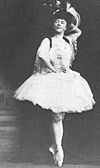
|
| Retire | ʀətiʀe | "withdrawn" | Pose, the free leg foot is placed on the knee of the standing leg |

|
| Révérence | ʀeveʀɑ͂s | (Proper name) | Bowing of the dancer |

|
| Round | ʀɔ͂ | "Circle" | - | - |
| Rond de jambe par terre | ʀɔ͂dʒɑ͂bpaʀtɛʀ | "Leg circle on the floor" | circular movement of the leg on the floor. |

|
| Rond de jambe en l'air | ʀɔ͂dʒɑ͂bɑ͂lɛʀ | "Leg circle in the air" | circular movement of the leg in the air. | - |
S. |
||||
| Sauté | sote | "Jumped" | almost every pose and every step can be jumped | - |
| Jeté sauté | ʒətesote | "Jumped throwing" | Jump from one leg to the other | - |
| Temps levé sauté | tɑ͂ləvesote | "Jumped, floating beat" | Jump from one leg to the same leg | - |
| Soubresaut | subʀəso | "Sentence, jump" | Jump with a slight forward movement from the V to the V position, the body is bent backwards strongly, the legs are held together and stretched backwards. | - |
| Soutenu | sut (ə) ny | "Persistent, tense" | Turn to (half) toe in the fifth foot position | - |
| Sousous | susu | "Held, carried" | Contraction of the legs from an open to a closed foot position | - |
| Free leg | - | - | Leg that executes a movement in a sequence of movements without weight load, while the supporting leg remains on the floor or carries the body weight | - |
| Mainstay | - | - | Leg that remains on the floor during a movement sequence or carries the body weight, while the other leg (free leg ) performs a movement without any weight load | - |
| Sur le cou-de-pied | syʀləkudpje | "On the ankle" | Foot position, the free leg foot is placed on the ankle of the standing leg |
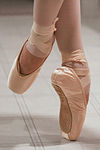
|
T |
||||
| Temps | tɑ͂ | "Counting time, counting times" | - | - |
| Temps levé sauté | tɑ͂ləvesote | "Jumped, floating beat" | Jump from one leg to the same leg | - |
| Temps lié | tɑ͂lje | "Connected counting time" | Connection step | - |
| trip | doʀ | "Rotation" | each pose can also be danced en tournant , i.e. rotated | - |
| Tour en l'air | tuʀɑ͂lɛʀ | "Rotation in the air" | virtuoso jumps of the dancer, in which he turns in the air. | - |
| Tutu | tyty | (Proper name) | Ballet skirt made of tulle fabric. |

|
| Tendu | tɑ͂dy | "Stretched" | the leg is stretched forwards, backwards or to the side | - |
| Battery tendu | batmɑ͂tɑ͂dy | "Straight hitting" | straight, extended movements of the extended free leg, the toes remain on the ground | |
| Battery tendu jeté | batmɑ͂tɑ͂dyʒəte | "Straight thrown hitting" | the extended free leg is thrown with a quick, gliding motion and lingers with the toes just above the ground in the air | - |
| Battement tendu pour battery | batmɑ͂tɑ͂dy puʀbatʀi | "Stretched hitting for battery " | quick change of the extended free leg behind and in front of (or in front of and behind) the supporting leg | - |
| Tombé | do | "Fallen down" | Shifting weight onto the bent free leg | - |
literature
- Agrippina J. Waganowa , Michael Schulze (illustrations): Basics of classical dance (original title: Osnovy klassičeskogo tanca , translated by Jochen Scheibe). 2nd Edition. Henschel, Berlin 2009 (German first edition 1954), ISBN 978-3-89487-418-6 .
- Gretchen Ward Warren: Classical Ballet Technique . University of South Florida Press, Tampa 1989, ISBN 978-0-8130-0895-0 (English).
- Irmingard Seidel-Reisner (Ed.): Darcey Bussel: Ballet . Translated from the English by Hans-Joachim Wiehager. Dorling Kindersley, Starnberg 2005, ISBN 978-3-8310-0734-9 .
- Eliza Gaynor Minden: The Ballet Companion: A Dancer's Guide to the Technique, Traditions, and Joys of Ballet . Simon and Schuster, New York 2005, ISBN 978-0-7432-6407-5 (English).
- Robert Greskovic: Ballet 101: A Complete Guide To Learning and Loving The Ballet . Hal Leonard Corporation, Pompton Plains 1998, ISBN 978-0-87910-325-5 (English).
- Sabrina Kuffer, Ursula Roth (illustrations): Ballet: pirouettes, tutu and lace dance . Knowledge is child's play, Regensburg 2007, ISBN 978-3-86751-000-4 .
- Horst Koegler, Klaus Kieser: Dictionary of dance . Reclam, Stuttgart 2009, ISBN 978-3-15-018661-9 .